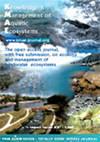硅藻基湖泊水质评价基质类型选择
IF 1.7
3区 环境科学与生态学
Q3 FISHERIES
引用次数: 2
摘要
不同的研究报告了不同的底物类型对硅藻群落组成的影响,但特别重要的问题是它是否影响基于硅藻的水质评价。研究了底物类型是否为硅藻群落组成的重要预测因子,以及底物类型是否影响基于硅藻指数的湖泊水质评价。这项研究在萨瓦湖(塞尔维亚)进行。我们使用玻璃、陶瓷、柳树和紫杉瓷砖作为外围植物发展的人造基质,并使用湖边的鹅卵石作为天然基质。结果表明,不同基质的硅藻群落组成和硅藻指数存在差异。人们认识到天然、人造木材和人造惰性基材之间的区别。然而,在我们研究的所有基质类型中,基于硅藻指数的最终湖泊质量评价或多或少相似,并且取决于与水质分类相关的值范围和硅藻指数的选择。在我们的研究中,人工基质确实显示出替代天然基质的潜力,但还需要进一步的研究,特别是在各种类型的生态系统中,以证实我们的发现,并支持人工基质在湖泊水质评估中的应用。本文章由计算机程序翻译,如有差异,请以英文原文为准。
Substrate type selection in diatom based lake water quality assessment
Various studies report contrasting results on the substrate-type effect on diatom community composition, but the particularly important question is whether or not it affects diatom-based assessments of water quality. We investigated whether the substrate type is a significant predictor of the diatom community composition and if it affects lake water quality assessment based on diatom indices. This study took place in Sava Lake (Serbia). We used glass, ceramic, willow and yew tree tiles as artificial substrates for periphyton development, and pebbles from the lake littoral as natural substrate. Results revealed differences in both the diatom community composition and diatom indices values related to the substrates. A distinction was recognized between natural, artificial wooden, and artificial inert substrates. However, the final lake quality assessment based on diatom indices was more or less similar in all substrate types in our study, and depended on value ranges associated with water quality classification and on diatom index choices. Artificial substrates in our study did show potential as an alternative for natural substrate, but further studies are required, particularly in various types of lentic ecosystems to confirm our findings and support artificial substrate employment in lake water quality assessment.
求助全文
通过发布文献求助,成功后即可免费获取论文全文。
去求助
来源期刊

Knowledge and Management of Aquatic Ecosystems
环境科学-海洋与淡水生物学
CiteScore
3.70
自引率
5.60%
发文量
22
审稿时长
>12 weeks
期刊介绍:
Knowledge and Management of Aquatic Ecosystems (KMAE-Bulletin Français de la Pêche et de la Pisciculture since 1928) serves as a foundation for scientific advice across the broad spectrum of management and conservation issues related to freshwater ecosystems.
The journal publishes articles, short communications, reviews, comments and replies that contribute to a scientific understanding of freshwater ecosystems and the impact of human activities upon these systems. Its scope includes economic, social, and public administration studies, in so far as they are directly concerned with the management of freshwater ecosystems (e.g. European Water Framework Directive, USA Clean Water Act, Canadian Water Quality Guidelines, …) and prove of general interest to freshwater specialists. Papers on insular freshwater ecosystems and on transitional waters are welcome. KMAE is not a preferred journal for taxonomical, physiological, biological, toxicological studies, unless a clear link to ecological aspects can be established. Articles with a very descriptive content can be accepted if they are part of a broader ecological context.
 求助内容:
求助内容: 应助结果提醒方式:
应助结果提醒方式:


